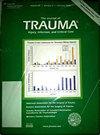Acute compartment syndrome in patients on long-term anticoagulation therapy
Journal of Trauma-Injury Infection and Critical Care
Pub Date : 2019-01-01
DOI:10.35841/2591-7358.3.1.1-5
引用次数: 2
Abstract
Development of acute compartment syndrome (ACS) poses problems for patients on long-term anticoagulation, who are at higher risk for hemorrhagic insult. The populations predisposed to ACS and long-term anticoagulation individually are quite different, making this a particularly unique population that has been rarely studied. Eight patients at our institution were included in this study based on development of ACS while being on long-term anticoagulation. Causes of ACS were almost evenly split between idiopathic, fracture, and blunt trauma without fracture. The most commonly involved compartment was the lower leg. ACS was appropriately diagnosed based on clinical assessment alone in all patients, based on heightened level of suspicion. All patients were treated with single- or double-incision fasciotomy, as is the standard of treatment in the general population. All patients experienced good outcomes post-fasciotomy with prompt bridging to anticoagulant regimen, with minimal complications and no cases of mortality. These patients were not revealed to have any identifiably unique risk factors for developing ACS, and they can be treated similarly to patients not on anticoagulation and adequately bridged to therapeutic anticoagulation levels.急性筋膜室综合征患者长期抗凝治疗
急性间室综合征(ACS)的发展给长期抗凝治疗的患者带来了问题,他们有较高的出血性损伤风险。易患ACS和长期抗凝治疗的人群是完全不同的,这使得这是一个特别独特的人群,很少被研究。本研究纳入我院8例长期抗凝治疗期间发生ACS的患者。ACS的病因几乎平均分为特发性、骨折和无骨折的钝性创伤。最常见的受累腔室是小腿。在所有患者中,基于高度的怀疑,仅根据临床评估就可适当诊断ACS。所有患者均行单切口或双切口筋膜切开术,这是一般人群的标准治疗方法。所有患者在筋膜切开术后均获得良好的预后,并及时转入抗凝治疗方案,并发症最少,无死亡病例。这些患者没有发现任何可识别的发展为ACS的独特危险因素,他们可以与未使用抗凝治疗的患者类似,并充分桥接到治疗性抗凝水平。
本文章由计算机程序翻译,如有差异,请以英文原文为准。
求助全文
约1分钟内获得全文
求助全文
来源期刊

Journal of Trauma-Injury Infection and Critical Care
CRITICAL CARE MEDICINE-EMERGENCY MEDICINE
自引率
0.00%
发文量
0
审稿时长
3 months
 求助内容:
求助内容: 应助结果提醒方式:
应助结果提醒方式:


